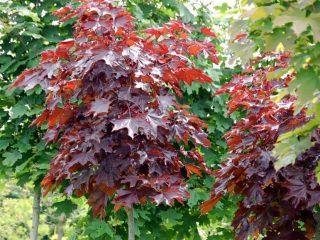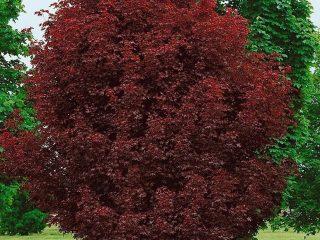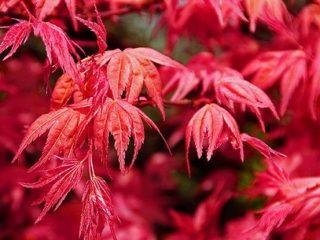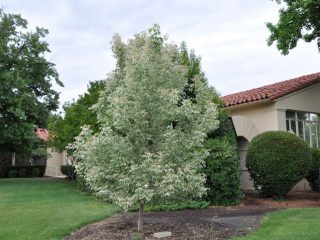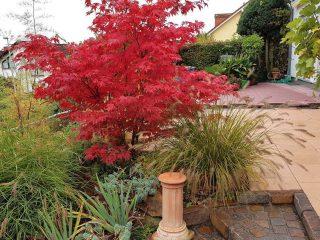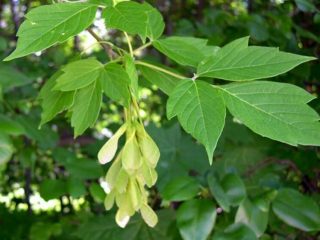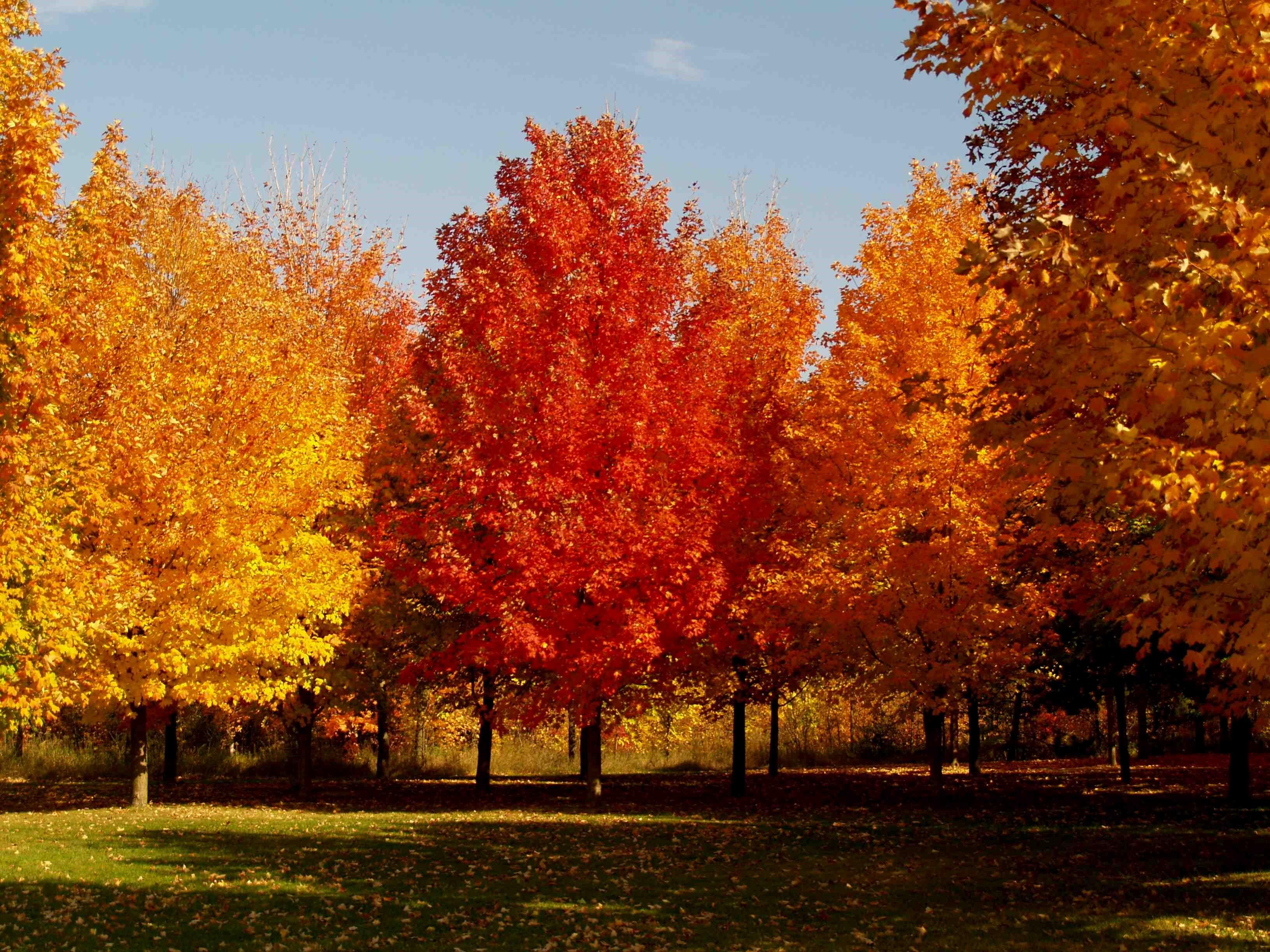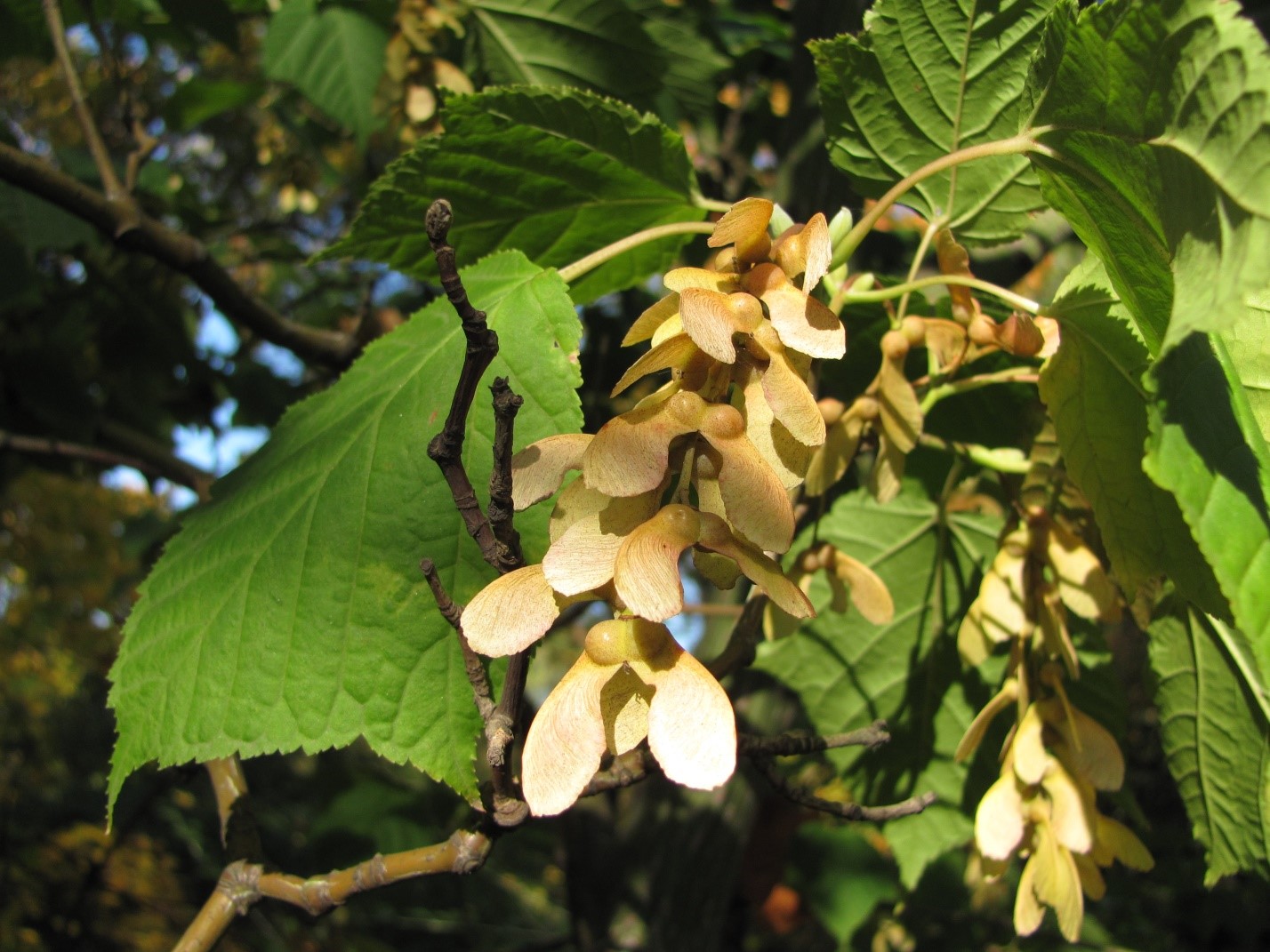Content
- 1 What does a Canadian maple look like?
- 2 Where does the Canadian maple grow?
- 3 The difference between Canadian maple and Russian
- 4 Types of Canadian maple
- 5 Planting a Canadian maple
- 6 Caring for Canadian Maple
- 7 Reproduction of Canadian maple
- 8 Diseases and pests
- 9 Application
- 10 How to get rid of Canadian maple
- 11 Conclusion
Canadian maple (Acer saccharinum) is an ornamental tree that is ideal for landscaping. The culture is characterized by a lush crown, as well as the ability to change the shade of the leaves from green to red-orange with the arrival of autumn. This tree does not require complex care, has high frost resistance and tolerates polluted air well. With proper care, it can grow in one place for up to four hundred years. In order for the plant to fully develop, it is necessary to become familiar with some of the features of its cultivation.

This maple leaf is featured on the Canadian flag.
What does a Canadian maple look like?
The maple is a slender, graceful tree, the height of which on average is 28-35 m, but in some specimens it can reach up to 40 m. The thickness of the trunk ranges from 78-91 cm. The bark is rough, hard, with deep cracks, light gray or brown-brown shade, as the tree matures it noticeably darkens.
The crown is lush, dense, spreading. The root system is well developed, branched, and goes into the deep layers of the soil. The branches are smooth, shiny, red-brown.
The leaves of the Canadian red maple, as seen in the photo, consist of several pointed blades, along the edges of which there is serration. Their length and width range from 5-22 cm. The leaves have long petioles and are located oppositely on the shoots. On top they are dark green in color, and on the back they are lighter and have a silvery tint. With the arrival of autumn, the shade of the plates changes sharply to bright orange with reddish highlights. This gives the tree a special decorative effect.
The flowering period begins in May and lasts about two weeks. The buds are small, collected in clusters of 8-14 pieces. They are greenish-yellow in color and are held on a long petiole. Flowers appear from the leaf axils at the top of young shoots. Maple is a dioecious tree. Therefore, it has female and male flowers that grow on different branches. After pollination, winged fruits appear on the tree, sitting on a long reddish petiole with two lobes. They contain two brightly colored seeds, 2-2.5 cm long.

When ripe, the fruits detach from the petiole and are carried by the wind over long distances, which contributes to the spread of the crop
Where does the Canadian maple grow?
North America is considered the birthplace of the culture. Now this tree can be found in natural conditions in Canada, the eastern part of the USA, and also in Scotland. It is the dominant crop in mixed and deciduous forests. This tree is unpretentious, therefore it is undemanding to the composition of the soil.
The culture easily adapts to any climatic conditions. Therefore, it has become widespread in many countries of the world.The Canadian maple has taken root well in Russia, and it is fully developing even in regions with risky farming.

The culture is able to survive in swamps and dry forests, but is afraid of drafts
The difference between Canadian maple and Russian
Canadian maple, like Russian maple, belongs to the same Sapindaceae family. But, despite the fact that they are relatives, they have certain differences. Canadian juice is clear with a high sugar content of 2 to 5%, while Russian juice is milky. In the first, autumn leaves have a rich red-orange hue, while in the second, yellow color predominates.
The height of the Canadian species in most cases exceeds 30 m, while for the Russian it is 12-28 m. The bark of the first is rough and rough, while the second has only narrow cracks.

In the Canadian species, the leaf shape is close to triangular, while in the Russian species it is wider, branched
The vegetative buds of the first are purely green, while those of the second have a reddish tint. The Canadian tree has spherical seeds, while the Russian tree has flattened seeds.
Types of Canadian maple
There are several types of this culture. Each of them has certain features that make it stand out from the rest. Therefore, when choosing, you should pay attention to them in order to choose the most optimal option in each specific case.
Common types:
- Laciniatum Wieri. It is a low-growing tree, compared to other maples, whose height reaches 12-15 m. The crown is asymmetrical, lush, very free. Its diameter is 8-15 m. The leaves of the Lacyanatum Vieri maple have different leaves, and when the buds open they have a bronze tint. In summer, the plates become light green, and with the arrival of autumn they acquire a lemon color.The inflorescences of this species are brown-red. The bark is green, and there are many small cracks on its surface. This species tolerates high frosts and polluted air well.
Maple Lacyanatum Vieri suffers from strong winds
- Adirondack. A medium-sized tree, up to 20 m high. Characterized by a lush, spreading crown. The branches and trunk are covered with brown bark, on the surface of which there are many small cracks. Adirondack maple leaves have five pointed segments. When they bloom and during the active growing season of the tree, they are green, and in the fall they acquire a bright crimson hue with yellow and orange highlights. The species is highly frost-resistant, but the branches easily break under gusts of wind.
Adirondack maple suitable for single and group plantings
- Pyramidale A medium-sized variety of maple, the height of which does not exceed 20 m. The crown is oval, dense, with a diameter of 8-10 m. Flowering is early, occurs in March, the buds are red-orange. The bark is gray in color, dotted with small furrows. The leaves are deeply cut with pointed lobes. During the active growing season of the tree, they are a rich light green hue, and on the reverse side they are silvery. With the arrival of autumn, the plates turn yellow.
In severe winters, the branches of the Pyramidal maple may freeze
- Freemanii Autumn Blaze. A hybrid form of Canadian maple with an oval or round lush crown. The height of the tree ranges from 18-25 m. The trunk and main skeletal branches are covered with smooth gray bark, but as the maple matures, it darkens significantly and becomes covered with small cracks. The leaves of this variety are deeply cut with pointed lobes.Throughout the summer they remain dark green in color, and with the arrival of autumn they turn purple-orange.
Freeman Automatic Blaze is characterized by accelerated development
Planting a Canadian maple
Both sunny open areas and slightly darkened areas are suitable for this tree. However, in the first case, the color of the foliage will be more saturated. Planting can be done in spring and autumn, but when growing Canadian maple in Siberia, the first option is considered preferable. It is recommended to plant one-year-old plants with a well-developed root system without signs of disease, which guarantees their rapid adaptation to a new location.
For planting, you need to prepare a hole with a depth and width of 60 cm. During the procedure, you can bury the seedling into the soil no more than 50 cm. When planting, you need to carefully straighten the roots, sprinkle them with soil, carefully fill all the voids and compact the soil. When finished, the tree should be watered thoroughly.
Caring for Canadian Maple
The deep red Canadian maple belongs to the category of undemanding crops. You need to care for the tree only at the initial stage of seedling growth in order to give it the opportunity to quickly grow stronger. To do this, it is necessary to control soil moisture, preventing the root system from drying out. Therefore, watering during a long absence of rain should be timely, soaking the soil up to 15 cm at the base of the seedling.
It is also recommended to fertilize the Canadian maple in the first three years after planting. To do this, you need to use urea in the spring at the beginning of the growing season at the rate of 30-50 g per plant.It is recommended to carry out the second feeding at the end of June, using nitroammophoska 30-50 g, and the third in mid-August - 40-80 g of superphosphate and 30-50 g of potassium sulfide. Fertilizer granules must be scattered evenly in the root circle and then sprinkled with soil.
The first three years after planting, the seedling needs to be insulated for the winter. Therefore, in late autumn, after the leaves have fallen, it is recommended to lay mulch at its base from pine litter, peat or humus, up to 5 cm thick. It is also recommended to wrap the crown with agrofibre in several layers.

Canadian maple does not need crown formation
Reproduction of Canadian maple
You can get new Canadian maple seedlings using seeds and cuttings. In the first case, the seed collected in the fall must be planted in a soil mixture of peat and sand, taken in equal quantities, and placed in the bottom of the refrigerator for three months. In April-May, the seeds should be planted in open ground in furrows to a depth of 4-5 cm and watered abundantly. Under favorable conditions, seedlings appear after two weeks. As the seedlings grow, they need to be planted, giving them the opportunity to fully develop. And when they are well strengthened, they can be moved to a permanent place.
To propagate Canadian maple by cuttings, it is necessary to use young shoots of an adult tree, dividing them into parts 25 cm long. They should be harvested in the fall after leaf fall. In winter, it is recommended to bury the shoots in damp sand and store them until April. Planting into the soil can be done when it has warmed up well to a depth of 10 cm.
After this, you need to build a mini-greenhouse over the cuttings to ensure their successful rooting. It needs to be ventilated every day for half an hour, and it is also recommended to control the soil moisture and, if necessary, water. Red maple cuttings take root after a month.
Diseases and pests
One of the most dangerous pests of this tree is the Asian longhorned beetle (Anoplophora glabripennis). Its larvae bite into the wood, making wide, intricate passages up to 30 cm long. This leads to disruption of metabolic processes and causes drying out of the Canadian maple.

In the absence of means of protection, the pest can cause mass destruction of plantings
Controlling the Asian longhorned beetle is difficult, so it is important to pay increased attention to prevention. Also, damage to the Canadian maple can be caused by aphids and bark beetles. Therefore, the tree must be periodically treated with insecticides when alarming signs appear.
Canadian maple is susceptible to diseases such as verticillium, various types of rot, ash and leaf spot. Therefore, when characteristic symptoms appear, it is recommended to remove damaged shoots and leaves, and then treat with copper-containing preparations.
Application
The Canadian species is widely used as an element of landscape design. It looks impressive both in single and group plantings. It is widely used for landscaping parks, squares, and recreation areas.
The crop is also valued for the strength of its wood. In terms of its characteristics, it surpasses even oak. During processing, Canadian maple wood darkens and acquires a pink or yellow tint with a shine, so it is in great demand among designers.It is used in the production of furniture, finishing materials, musical instruments, dishes, and skis.
Canadian maple sap is also a valuable product. It is used in cooking to give dishes an original taste. Syrup based on it is very popular in the USA and Canada. It is added to pancakes.

Canadian maple wood is easy to paint, polish and varnish
How to get rid of Canadian maple
Maple has the ability to reproduce by self-seeding, which can lead to the appearance of unwanted plantings. If the number of new young seedlings is small, it is recommended to dig them up. You can also combat unwanted vegetation by covering it with black film for the season.
In case of mass reproduction of Canadian maple, it is recommended to use the herbicide Roundup. It is necessary to prepare a solution of high concentration and apply it to the leaves with a brush or spray it with a spray bottle.
Conclusion
Canadian maple belongs to the category of deciduous trees, the cultivation of which does not cause any problems. This culture is able to survive in any climate and purify the air well. However, when planting, you need to take into account that it does not tolerate drafts well, which can lead to branches breaking off and becoming severely frozen in winter. And this reduces the decorative value of the tree and weakens its viability.




